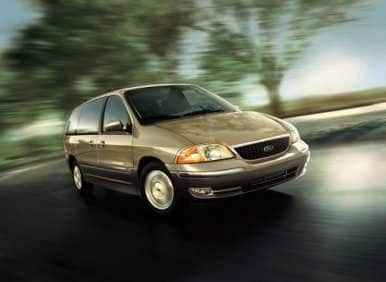Recent Articles
Popular Makes
Body Types
Ford Windstar Used Minivan Buyers Guide
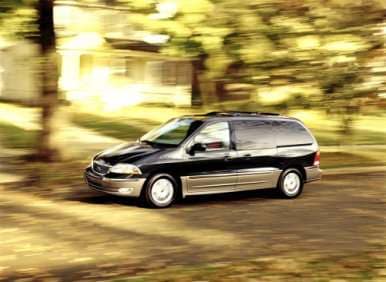
While the Chrysler Corporation is credited with inventing the modern minivan, the idea actually got to Chrysler via Ford. Back in 1972, Ford showed a minivan concept called the Carousel, an idea of Lee Iacocca, then president of Ford and the lead executive responsible for the success of the Mustang. That 1972 Ford Carousel concept was arguably the progenitor of the modern minivan.
Here’s why.
Ford had shepherded the Carousel concept well towards production when the first Arab oil crisis hit in 1979. That event drove consumers toward smaller vehicles and made Ford's top management feel further developing a vehicle like the Carousel would be unprofitable. Shortly afterward, Lee Iacocca left Ford and landed in the top spot at Chrysler. One of his first activities there was to revive the Carousel concept. He used the Chrysler K car as the platform, and in so doing brought the first modern front-drive minivan to market—ushering in the configuration all minivans are built around to this day.
However, had the executive management team at Ford truly had a better idea of what was to come in years ahead they would have stuck with the Carousel. One need only look at the success of the Chrysler Town & Country and all the minivans that concept spawned to see that Iacocca (just as he had been with he Mustang) was once again ahead of the game. Ford would have been in the leadership position in minivans, and arguably a lot more profitable. Instead, Ford had to play catch-up in the minivan arena. One of the vehicles they came up with in that regard is the subject of this minivan buyer’s guide; the Ford Windstar.
Introduced in model year 1995, as a replacement for the rear-drive Ford Aerostar, the Ford Windstar was Ford's first front drive minivan. Lasting but two generations, the Windstar was built from 1995 to 2003, before being replaced by the Ford Freestar.
Ford Windstar Used Minivan Buyers Guide: 1995 – 1998
For a product of 1995, the Ford Windstar was a rather competitive minivan. With features like dual airbags, antilock brakes, a four-speed automatic transmission and a V6 engine the Windstar was firmly in the hunt. Featuring seating for seven and an integrated child seat, the Windstar was also remarkably family-friendly.
Based on the platform underpinning the Ford Taurus, some of the philosophy of the styling of the Taurus bled over into the Windstar as well. Its sleek design was evocative of the same mindset that produced the Taurus. Additionally, the Windstar drove like a tall Taurus. With its good looks and easy handling, the Windstar proved to be the right product at the right time.
Speaking of time, Ford's timing for the Windstar was also quite fortuitous. The ‘95 Windstar hit the market a year before Chrysler's minivans were slated to be updated. Thus, the 1995 Ford Windstar was the most current minivan offering on the market for well over a year after its introduction.
By the way, that V6 engine was a 155 horsepower, 3.8-liter powerplant, capable of generating 220 foot-pounds of torque. It ran on regular fuel and with it, the Windstar would tow 2000 pounds.
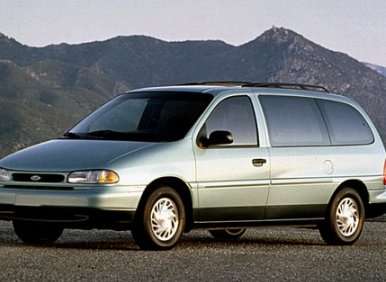
Ford Windstar Used Minivan Buyers Guide: 1995
Windstar went on sale in March of 1994, as a 1995 model. At launch, it was available in but one state of trim; “GL”. By the end of the 1995 model year, going into 1996, a second trim level had been added, designated “LX”. Toward the end of the 1995 model year, a second V6 engine was also introduced—this one displacing 3.0 L and producing 147 hp and 170 foot-pounds of torque—was installed in the base GL minivan, designated a 1995.5 model. The four-speed automatic transmission was also paired with that engine.
The standard equipment list for the 1995 Ford Windstar GL minivan contained a pair of Captain’s chairs for the driver and front passenger, power brakes, a third row seat, tinted glass, and 15-inch steel wheels with wheel covers. The Windstar GL featured four-wheel ABS, driver and passenger front airbags, seating for seven, power steering, intermittent windshield wipers, a rear window wiper, and cloth upholstery. Entertainment was provided by way of an AM/FM audio system.
For 1995, the Windstar GL's options list contained a camper/towing package, a center console, an integrated child seat, a keyless entry system, a rear window defroster, front and rear air-conditioning, a set of alloy wheels, seating for five passengers, cruise control, a tilt steering wheel, power windows, privacy glass, power door locks, power exterior mirrors, and a roof rack. The two optional audio systems were an AM/FM/cassette-based unit and an AM/FM/CD head unit.
The standard equipment list for the 1995 Ford Windstar LX minivan contained all of the GL's equipment plus; a lighted entry system, two-tone paint, alloy wheels, a power driver’s seat, leather trim for the steering wheel, power door locks, power windows, and power exterior mirrors. The base LX audio system was an AM/FM/cassette-based unit.
Optional features for the LX, not listed on the GL’s options sheet included; four Captain’s chairs, heated exterior mirrors, a compact disc changer, a digital instrument panel, leather upholstery, an antitheft alarm system, and an auto dimming rearview mirror. The LX also got an optional premium audio system by JBL, which was driven by an AM/FM/CD-based head unit.
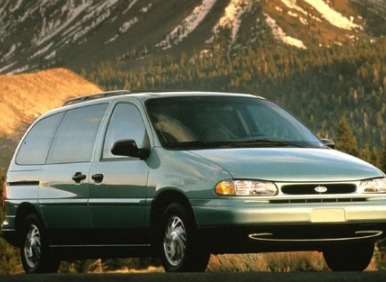
Ford Windstar Used Minivan Buyers Guide: 1996
For the 1996 model year, Ford added traction control and four-wheel disc brakes to the Windstar’s options list. The 3.8 L engine became optional for the GL, its power output increased to 200 hp. The Windstar LX got the improved 3.8 L V6 as standard equipment. Revisions to the engine extended its tune-up intervals to 100,000 miles. Under seat storage was added to the GL, and a new integrated child safety seat was added to the options list. The driver seat was fitted with an available tilt/slide feature to enable more ready access to the rear compartment from the driver’s side of the Windstar.

Ford Windstar Used Minivan Buyers Guide: 1997
To make the Windstar’s starting MSRP more competitive, a base model was added to the lineup for the 1997 model year.
This version was fitted with a 3.0 L V6, 15-inch wheels, two Captain’s chairs, power brakes, a third-row seat, tinted glass, four-wheel ABS, driver and passenger front airbags, seating for seven passengers, cloth upholstery, power steering, intermittent windshield wipers, a rear window wiper, and an AM/FM audio system.
Options for the base model included a rear window defroster, two child seats, cruise control, a tilt steering wheel, air-conditioning, power windows, power door locks, power exterior mirrors, and an AM/FM/cassette-based audio system.
While the standard features of the GL were largely the same as the base model, the differentiation came in the optional equipment available for the GL. Front and rear air conditioning, the camper/towing package, a center console, the keyless entry system, the 3.8 L V6, alloy wheels, and traction control were not made available to buyers of the base model.
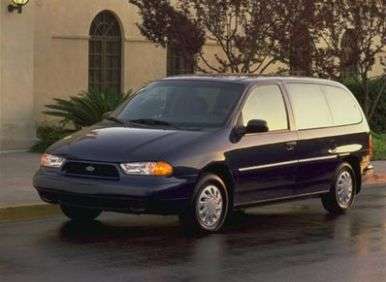
Ford Windstar Used Minivan Buyers Guide: 1998
In an effort to make up for the lack of a sliding rear door on the driver’s side, the Windstar sprouted a wider driver’s door in an effort to appease buyers looking for better ingress for the left side of the vehicle.
Additionally, the Windstar's lineup expanded upwardly for 1998, with the introduction of a Limited trim line. Standard features for the 1998 Ford Windstar Limited included four Captain’s chairs, fog lights, a lighted entry system, an overhead console, power brakes, and a rear window defroster. The Windstar Limited also offered a third row seat, tinted glass, 16-inch alloy wheels, front and rear air conditioning, four-wheel ABS, driver and passenger front airbags, leather upholstery, and a power driver’s seat.
Other standard features included cruise control, power steering, a leather wrapped tilt steering wheel, intermittent windshield wipers, a rear window wiper, power windows, power door locks, power exterior mirrors, automatic headlamps, and an auto dimming electrochromic rearview mirror. The standard audio system was an AM/FM/cassette-based unit.
The Windstar Limited options list offered privacy glass, a self-leveling suspension system, a camper/towing package, a center console, heated exterior mirrors, and a keyless entry system. For entertainment, buyers could choose either an AM/FM/CD audio system or an AM/FM/cassette/CD audio system. Both head units were paired with JBL amplification and speakers.
Additionally, the 1998 Windstar Limited offered traction control, a roof rack, an antitheft alarm system, and cloth seating also as optional equipment.
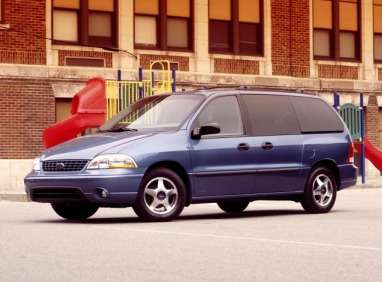
Ford Windstar Used Minivan Buyers Guide: 1999 – 2003
With the 1999 redesign, Ford's product planners attempted to address all of the shortcomings of the first-generation Windstar. Built on a dedicated platform, dual power sliding doors finally debuted on Ford's minivan.
The engines were carried over from the previous generation; however, the 3.8-liter V6 was slightly reworked to produce 15 more foot-pounds of torque, upping its output to 240. Similarly, output of the 3.0 L V6 was increased to 150 hp and 172 foot-pounds of torque. The transmission, brakes, and air-conditioning systems were also upgraded.
Other new features like front seat mounted side airbags and rear reverse sensors brought the Windstar more sharply into competition with the top-selling minivans of the time. Rollers were added to the second and third row seats to make them easier to remove (and replace), the instrument panel was reworked to improve ergonomics, and the suspension system was redesigned in an effort to improve both ride and handling.
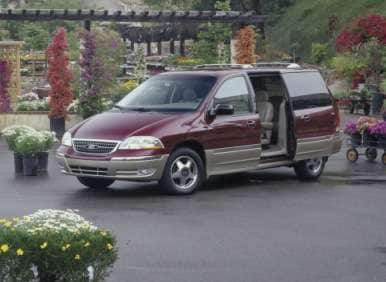
Ford Windstar Used Minivan Buyers Guide: 1999
The 1999 Ford Windstar minivan debuted in four levels of trim, “Base”, “LX”, “SE”, and “SEL”.
Standard equipment on the 1999 Ford Windstar base minivan included two Captain’s chairs, power brakes, a third row seat, tinted glass, 15-inch steel wheels with wheel covers, a four-speed automatic transmission, four-wheel ABS, driver and passenger front airbags, seating for seven, cloth upholstery, power steering, intermittent windshield wipers, a rear window wiper, and an AM/FM audio system.
The base model’s options included front side air bags, a keyless entry system, a rear window defroster, sliding driver’s-side door, cruise control, tilt steering wheel, air conditioning, power windows, privacy glass, power door locks, power exterior mirrors, and an AM/FM/cassette audio system.
In addition to the 3.8 L V6 engine, the LX trim built upon the base model’s standard feature set with a lighted entry system, cruise control, power windows, power door locks and power exterior mirrors, in addition to an AM/FM/cassette audio system. Options for this trim line above what was available on the base model included front bucket seats, heated exterior mirrors, four Captain’s chairs, a center console, a compact disc changer, an overhead console, front and rear air conditioning, a roof rack, a power driver’s seat, alloy wheels, dual power sliding side doors, and traction control. The optional LX audio system was based around an AM/FM/cassette/CD head unit.
The vast majority of the optional features for the LX trim were incorporated as standard features on the SE trim line. Options for the SE not available on the LX included a camper/towing hitch, an integrated garage door opener, spoke wheels, and leather upholstery.
To get to the SEL trim line, Ford's product planners incorporated all of the optional features for the SE as standard equipment on the 1999 Windstar SEL. However, the camper/towing package, traction control, front side air bags, and the antitheft alarm system were optional for the SEL as well.
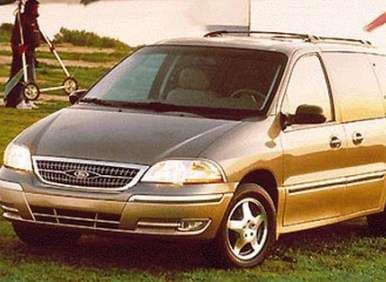
Ford Windstar Used Minivan Buyers Guide: 2000
A power adjustable pedal set was introduced as standard equipment. Rear seat video entertainment debuted, based on videotape. Also, the top-of-the-line second generation Ford Windstar Limited came to market.
Basically incorporating all of the features (both standard and optional) for the Windstar SEL, the only option available for the 2000 model year Ford Windstar Limited was a set of four Captain's chairs.
This meant the 2000 Ford Windstar Limited came standard with a camper/towing package, a center console, an integrated garage door opener, heated power adjustable exterior mirrors, a keyless entry system, a lighted entry system, an overhead console, and power brakes.
Other standard features included a sliding driver’s side door, a rear window defroster, a third row seat, tinted glass, a unique set of 16-inch alloy wheels, front and rear air-conditioning, a 3.8 L V6, the four-speed automatic transmission, traction control, and four-wheel ABS.
The Windstar Limited also featured driver and passenger front airbags, front side air bags, an antitheft alarm system, seating for seven passengers, leather upholstery, power seats for both the driver and front passenger, cruise control, and power adjustable pedals. Power steering, leather wrapped tilt steering wheel, intermittent windshield wipers, power windows and door locks, privacy glass, and a rear window wiper were also included. The inside rearview mirror dimmed automatically, the headlights turned on and off automatically, there was a roof rack, a power sliding side door and the audio system was driven by an AM/FM/cassette/CD changer head unit.
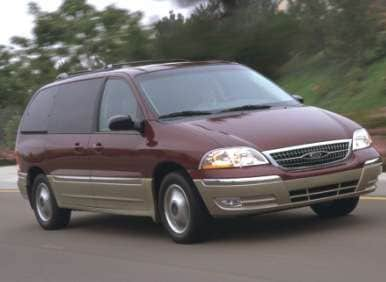
Ford Windstar Used Minivan Buyers Guide: 2001
The 3.0 L V6 was discontinued, making the 3.8 the only engine choice. With the demise of the 3.0-liter V6, the base model was also laid to rest, making the new base trim the Windstar LX. Windstar models with second row bucket seats got a center console, and the steering wheel was updated.
An SE sport trim line debuted, equipped with driving lights, painted bumpers and body-side molding, a tail spoiler on the rear liftgate, a second-row bucket/console seat, a roof rack with brushed aluminum crossbars, black lower cladding, and an SE Sport-specific set of wheels and tires.
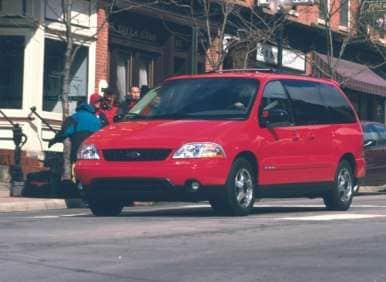
Ford Windstar Used Minivan Buyers Guide: 2002 / 2003
Dual sliding doors became standard equipment on all Windstar models; the video entertainment system was made available across the board, as were 16-inch alloy wheels. The SE Sport was discontinued, as was the leather option for SE. However, the painted bumpers and driving lights from the SE Sport found their way onto the LX.
The base trim line returned to the lineup, and Ford’s AdvanceTrac stability control was offered as an option.
